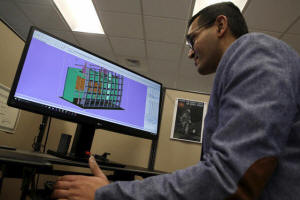|
Exclusive: Boeing's space taxis to use
more than 600 3D-printed parts
 Send a link to a friend
Send a link to a friend
 [February 04, 2017]
By Alwyn Scott [February 04, 2017]
By Alwyn Scott
SEATTLE (Reuters) - Boeing Co has hired a
small company to make about 600 3D-printed parts for its Starliner space
taxis, meaning key components in the United States manned space program
are being built with additive manufacturing.
The company, privately held Oxford Performance Materials, will announce
a $10 million strategic investment from advanced materials company
Hexcel Corp as early as Friday, adding to $15 million Hexcel invested in
May and lifting Hexcel's equity stake to 16.1 percent, Oxford and Hexcel
said.
Boeing's award of the parts for its flagship space program and Hexcel's
funding are strategic bets that printed plastics can perform flawlessly
even under the extreme stress of a rocket launch and sub-zero
temperatures of space.
They offer further evidence of a shift in 3D printing from making
prototypes to commercial production of high-grade parts for space ships,
aircraft engines and other critical equipment.
Oxford's parts will help Boeing lower costs and save weight on each
seven-seat capsule, compared with traditional metal and plastic
manufacturing, Larry Varholak, president of Oxford's aerospace business,
said in an interview.
"What really makes it valuable to NASA and Boeing is this material is as
strong as aluminum at significantly less weight," he said. Boeing said
the weight savings on Oxford's parts is about 60 percent compared with
traditional manufacturing.

Boeing is building three Starliner capsules under a $4.2 billion NASA
contract. Entrepreneur Elon Musk's SpaceX is building a competing
capsule under a $2.6 billion NASA contract.
Oxford has already shipped parts for the Starliner. The plastic it uses,
known as PEKK, also resists fire and radiation, according to Oxford.
Boeing declined to say how much of the capsule Oxford's parts represent.
"It's a significant fraction of the Starliner from the aspects of
design, assembly and reliability of high integrity parts," said Leo
Christodoulou, director of structures and materials engineering at
Boeing. "Using Oxford's materials takes out a lot of cost."
"SHOW ME THE DATA"
Despite its promise and potential sales, customers and investors need to
be convinced by repeatable results from printed plastics.
"We're still in the show-me stage," Oxford Chief Executive Scott
DeFelice said in an interview. "If you don't show me the data I'm not
going to believe you."
Oxford, based in South Windsor, Connecticut, started as a materials
science company in 2000 and added 3D printing in 2006. It also makes
aircraft parts and cranial and facial implants, as well as replacement
human vertebrae.
In 2012 it delved into aerospace and defense. Working with NASA,
Northrop Grumman Corp and incubator America Makes, it demonstrated
printed PEKK could handle temperatures from minus 300 to 300 degrees
Fahrenheit among other qualities,
[to top of second column] |

Product Development Engineer Jigar Patel works with a CAD image of a
thrust reverser cascade in development at Oxford Performance
Materials Inc., the maker of more than 600 parts to be used on
Boeing's new Starliner manned spacecraft, in South Windsor,
Connecticut, the maker of more than 600 parts to be used on Boeing's
new Starliner manned spacecraft, in South Windsor, Connecticut,
U.S., January 31, 2017. REUTERS/Mike Segar

"It's everything from brackets supporting the propulsion system to
internal structures for the air revitalization system," Varholak
said of the parts for Boeing's Starliner.
Printing parts is often faster and less expensive than traditional
forging, machining or molding. It requires minimal tooling and touch
labor, and allows companies to keep a "digital inventory" of parts,
printing as needed, said Terry Wohlers, chief executive of
consulting firm Wohlers Associates, which has tracked additive
manufacturing for more than 20 years.
Use of 3D technology is surging. Sales reached $1 billion in 2007,
jumped to nearly $5.2 billion in 2015 and are expected to hit $26.5
billion by 2021, according to the Wohlers Report, which analyzes the
sector.
Several relatively small listed companies such as Stratasys Ltd, 3D
Systems Corp and ExOne Co offer investors exposure.
Other firms have been snapped up. General Electric last year bought
a controlling stake in Swedish 3D printing company Arcam AB and
Germany's Concept Laser, and launched an additive manufacturing
division. GE already prints metal parts for the new LEAP engine that
powers Boeing and Airbus SA single-aisle jetliners.
Aerospace already accounts for about 17 percent of 3D printing
revenue, ranking second after industrial and business machines but
ahead of automotive, consumer, electronics and medical products,
according to Wohlers.
Aerospace is a "near perfect fit" for 3D printing because it
involves complex, expensive parts made in relatively low volumes,
Wohlers said. The Starliner is due to blast off for the first time
in June 2018 from Cape Canaveral, and carry its first crew in August
2018. It will be launched on an Atlas V rocket supplied by United
Launch Alliance, a joint venture between Boeing and Lockheed Martin
Corp.
(Reporting by Alwyn Scott; Editing by Andrew Hay)
[© 2017 Thomson Reuters. All rights
reserved.]
Copyright 2017 Reuters. All rights reserved. This material may not be published,
broadcast, rewritten or redistributed.
 |